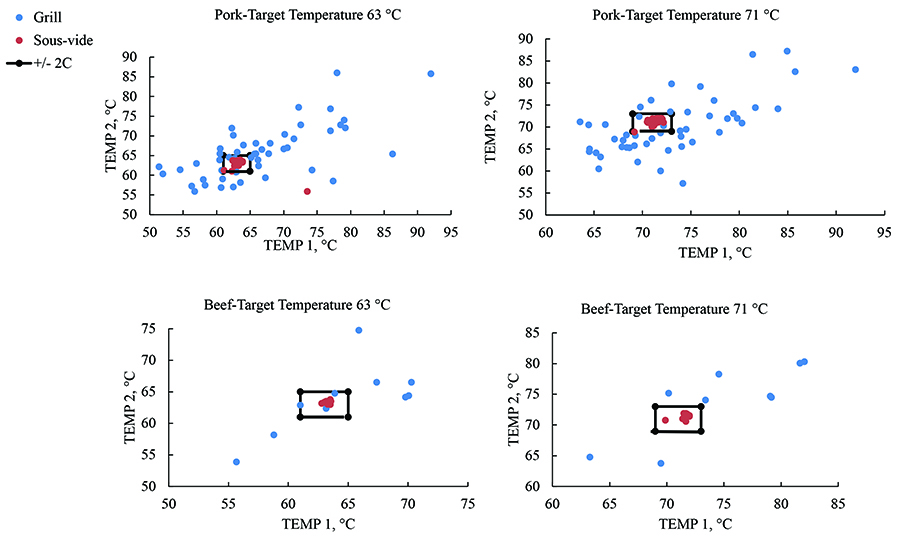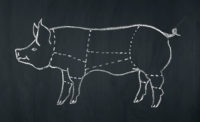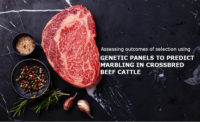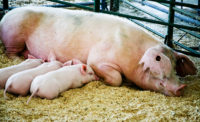Grilling is a commonly accepted cooking method used in meat quality research due to its short cooking time and affordability. However, grilling presents a number of challenges to ensure accurate and precise end-point temperatures, even when executed well. When monitoring internal temperature, the end-point temperature is dependent on correct thermometer placement. Even then, differences in temperature may be observed within a chop depending on probe location, or between chops depending on the presence of the grill’s hot and cold spots. It is also imperative to pay close attention during grilling to avoid meat overcooking.
Sous vide is a cooking method where cuts are submerged completely underwater, allowing them to be cooked evenly. Because the end-point temperature of cuts cannot rise above the set water temperature, samples prepared using sous vide cannot be overcooked. This also allows for the convenience of not having to monitor cuts closely during the cooking process. All of this likely results in reduced external variability and greater accuracy in analyses.
The objective of our work was to determine the end-point temperature and Warner-Bratzler shear force (WBSF) variability differences in pork and beef cooked to varying degrees of doneness using grilling and sous vide. Ten beef semitendinosus muscles were cut into four 2.54 cm steaks (N = 40) and aged for 21 days. Beginning at the 10th rib, 51 pork loins were cut into four 2.54 cm chops (N = 204) and aged for seven days. Steaks and chops were randomly allocated within the whole muscle to four treatments: grilled or sous vide to 63°C, or, grilled or sous vide to 71°C. After cooking, regardless of the applied method, two handheld thermometers were inserted into either side of the cut to determine the actual final temperature. Cuts were cooled to room temperature before four cores were removed parallel to the muscle fiber and evaluated for WBSF. One of the objectives was to measure accuracy and precision within end-point temperature and tenderness. Temperature accuracy was defined as how close thermometer readings were to the targeted cooked temperature (63 or 71°C). Temperature precision was defined as how similar two thermometer readings, within a single cut, were to each other. WBSF accuracy was defined as how close individual core values were to the cut average. WBSF precision was defined as how similar individual core values were to each other.
Figure 1

As expected, sous vide was more accurate and precise in the end-point temperature compared to grilling in both pork and beef cooked to varying degrees of doneness. The two recorded end-point temperatures for each cut graphed together illustrate the degree of accuracy and precision of sous vide compared to grilling (Figure 1). Of chops cooked to target 63°C, 98% of sous vide chops fell within ±2°C of the target end-point temperature, while only 4% of grilled chops did (Table 1). Of chops cooked to target 71°C, 98% of the sous vide chops fell within the target, while only 2% of the grilled chops did. Of steaks cooked to target 63°C, 100% of sous vide steaks were ±2°C of the target temperature, while only 30% of grilled steaks fell into that range. Of steaks cooked to target 71°C, again 100% of the sous vide steaks were within the target temperature range, while 0% of the grilled steaks fell into the target temperature range. Furthermore, temperature accuracy, the mean difference between average cooked temperature and target temperature, was improved by 7.5°C in sous vide chops compared to grilled chops. For steaks, temperature accuracy was improved by at least 3.7°C in sous vide cooked steaks compared to grilled steaks (Table 1).
Table 1
Effect of cooking method and target end-point temperature on end-point temperature precision and accuracy in pork loin chops and beef semitendinosus steaks
| 63°C | 63°C | 71°C | 71°C | P -values | P -values | P -values | ||
|---|---|---|---|---|---|---|---|---|
| Item | Grill | Sous vide | Grill | Sous vide | SEM | Method | Temperature | Method x Temperature |
| Pork chops1, n | 51 | 51 | 51 | 51 | ||||
| Average Cooked Temperature,°C | 64.85a | 62.08b | 70.41 c | 70.20 c | 0.87 | 0.02 | <0.01 | 0.04 |
| Temperature Range 2, °C | 4.05a | 0.23b | 4.16a | 0.21b | 0.55 | <0.01 | 0.88 | 0.91 |
| Temperature Accuracy 3, °C | 9.46a | 1.57b | 8.90a | 1.69b | 1.43 | <0.01 | 0.84 | 0.76 |
| Beef steaks 1, n | 10 | 10 | 10 | 10 | ||||
| Averaged Cooked Temperature, °C | 64.22a | 63.32a | 74.29b | 71.46b | 1.16 | 0.12 | <0.01 | 0.41 |
| Temperature Range 2, °C | 3.08a | 0.26b | 2.97a | 0.48b | 0.54 | <0.01 | 0.92 | 0.76 |
| Temperature Accuracy 3, °C | 4.04a | 0.34b | 5.64a | 0.64b | 0.60 | <0.01 | 0.12 | 0.28 |
1LS means in the same row containing differing superscripts are statistically different (P < 0.05)
2Mean difference between two measurements of end-point temperature made in each chop
3Mean difference between average cooked temperature and target temperature
Table 2
Effect of cooking method and target end-point temperature on Warner Bratzler shear force and cook loss in pork loin chops and beef
| 63°C | 63°C | 71°C | 71°C | P -values | P -values | P -values | ||
|---|---|---|---|---|---|---|---|---|
| Item | Grill | Sous vide | Grill | Sous vide | SEM | Method | Temperature | Method x Temperature |
| Pork chops1, n | 51 | 51 | 51 | 51 | ||||
| Average Warner-Bratzler shear force, kg | 2.97a | 2.68b | 3.10c | 3.67d | 0.10 | 0.06 | <0.01 | <0.01 |
| Range in shear force value2, kg | 1.51ab | 1.40a | 1.55ab | 1.72b | 0.13 | 0.77 | 0.04 | 0.12 |
| Coefficient of Variation | 18.63 | 18.55 | 18.55 | 18.34 | 0.01 | 0.88 | 0.88 | 0.95 |
| Cook loss, % | 17.37a | 18.20a | 21.30b | 28.33c | 0.58 | <0.01 | <0.01 | <0.01 |
| Beef steaks 1, n | 10 | 10 | 10 | 10 | ||||
| Average Warner-Bratzler shear force, kg | 3.47 | 3.5 | 3.59 | 3.8 | 0.17 | 0.49 | 0.22 | 0.6 |
| Range in shear force value 2, kg | 2.67a | 2.33a | 1.98ab | 1.34b | 0.29 | 0.10 | 0.01 | 0.60 |
| Coefficient of Variation | 28.24a | 24.36a | 21.19a | 13.53b | 0.02 | 0.03 | <0.01 | 0.45 |
| Cook loss, % | 25.69a | 30.45b | 31.36b | 38.72c | 0.81 | <0.01 | <0.01 | 0.12 |
1LS means in the same row containing differing superscripts are statistically different (P < 0.05)
2Difference between WBSF maximum and minimum value within a cut
It was also expected that the tenderness of chops and steaks would be less variable when sous vide compared to grilling. However, there was no significant difference in the variability of tenderness between cooking methods. For pork cooked to 63°C, grilled chops were less tender than sous vide (Table 2). When cooked to 63°C there were no significant differences in cook loss between the cooking methods; however, when cooked to 71°C, sous vide chops were less tender than grilled. This may be due to the difference in cooking loss percentage observed. Of chops cooked to 71°C, cooking loss of sous vide chops increased by 7 percentage units compared to the grilled chops. For beef steaks, tenderness was not different between cooking methods regardless of the target end-point temperature. However, cooking loss for steaks cooked to 63°C was 4.76 percentage units greater using sous vide than grilling. For steaks cooked to 71°C, cooking loss was 7.36 percentage units greater when sous vide compared to grilled (Table 2).
Sous vide cooking improved accuracy in reaching a desired, target end-point temperature. Sous vide also reduced end-point temperature variability. These data may be useful to meat science researchers looking for means to reduce external variability that may be introduced via cooking method. However, caution must be used with sous vide cooking at higher temperatures as it may result in greater WBSF.
For more information please see the authors' work published in Meat and Muscle Biology: Bryan E. E. & Shirey D. C. & Redifer J. D. & Harsh B. N. & Dilger A. C., (2021) “Endpoint Temperature and Tenderness Variability in Pork and Beef Cooked Using Sous-Vide Style Immersion Heaters and Grills”, Meat and Muscle Biology 5(1). p.18, 1 – 8. doi: https://doi.org/10.22175/mmb.11699




Report Abusive Comment